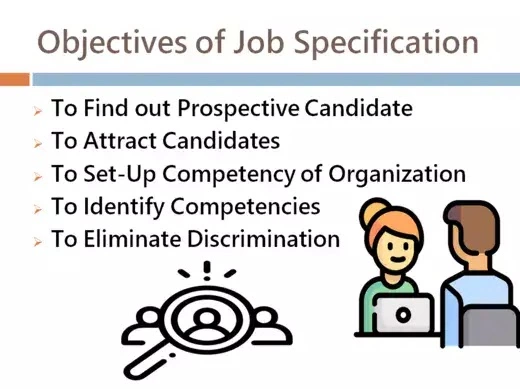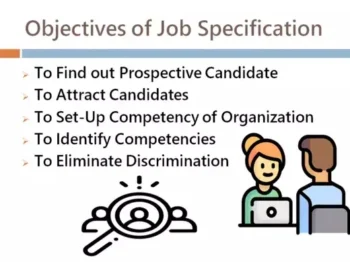Table of Contents:-
- Job Specification Meaning
- Job Specification Definition
- Objectives of Job Specification
- Contents of Job Specification
- Elements of Job Specification.
Job Specification Meaning
Job specification meaning – Job specification is also known as job requirement it is a by-product of job analysis. It covers all the human qualities to be considered such as physical, personal, and psychological responsibilities to be acquired, academic qualifications, experience, etc. It converts the job description into human qualifications so that the job can be done more efficiently. It assists in hiring the right person for the right position.
Job Specification Definition
Job specification is defined as “a list of a job’s ‘human requirements,’ including the requisite education, skills, personality, and so on.”
According to Edwin B. Flippo – “A job specification is a statement of the minimum acceptable human qualities necessary to perform a job properly”.
According to Dale Yoder – “Job specification as a summary is a specialised job description, emphasising personnel requirements and designed specially to facilitate selection and placement”.
Objectives of Job Specification
Objectives of job specification are as follows:

1) To Find out the Prospective Candidate
Job specification helps in the selection of a potential candidate for a vacant position. It helps in evaluating the resume more rapidly and impartially. It also helps in making a list of relevant questions for the interview.
2) To Attract Candidates
Related Article:- Nature of Organisational Behaviour
It is necessary to make the job specification professional and a good representative of the organisation’s image to the candidate. For this purpose, the job specification must be active and precise to attract talented candidates.
3) To Set-Up Competency of the Organisation
When an organization has set up its core competency, the job specification assists in executing the various competency programmes.
4) To Identify Competencies
It helps employers recognise the accurate duties and skills of the employee. It also makes the prospective candidates capable of ascertaining their capacity to satisfy the job requirements.
5) To Eliminate Discrimination
It helps in preventing the violation of equal employment opportunities laws. It sets a standard of basic skills needed for a job description and specifies the basic required qualifications or experience.
Contents of Job Specification
Contents of job specification relate to:
1) Physical Characteristics
It consists of age, health, strength, size of the body, body weight, poise, vision, etc.
2) Psychological Characteristics or Special Aptitudes
It covers qualities such as manual dexterity, mechanical aptitude, ingenuity, judgement, etc.
3) Personal Characteristics or Results of Temperament
It includes good and pleasing manners, personal appearance, emotional stability, aggressiveness or submissiveness, etc.
4) Responsibilities
It involves supervision, responsibility for the process, production and equipment, the safety of other people, preventing loss in monetary terms, etc.
5) Other Features of Demographie Nature
Age, sex, education, experience, language ability, etc.
| Educational Qualification | A degree or diploma in personnel management/HRM or any other related discipline from a recognised institution. |
| Work Experience | Minimum experience of 2 years in a similar post in a leading industry. |
| KSA (Knowledge, Skills and Abilities) | 1) Knowledge and expertise in the area of compensation administration in competing industries, procedures of job analysis, techniques of compensation survey, and performance appraisal issues. 2) Possess skills in writing job descriptions, conducting interviews for job analysis, making group presentations, in performing statistical calculations. 3) Ability to organise and conduct meetings. |
| Work Orientation Factors | The post may require 10 per cent of travelling. |
| Age | Maximum 30 years. |
Elements of Job Specification
Before an organization considers inviting people to apply for a job, they must decide what types of persons are to be invited and what their characteristics should be. This requires establishing ‘job specifications,’ also known as ‘man specifications.’ Job specifications are derived from job descriptions, which depend on the nature and requirements of a job. Thus, job specifications will vary for each job.
Various elements of job specification are explained below.
1. Physical Specifications: Certain jobs may require specific physical features. For instance, the assembly of a TV set or other electronic equipment may necessitate good vision, a typing job may require finger dexterity, and a physically demanding job may necessitate a strong, heavy, and robust body. The particular physical abilities and skills required for a given job must be specified. These may include height, weight, vision, finger dexterity, voice, poise, hand and foot coordination, motor coordination, colour discrimination, age range, etc.
2. Mental Specifications: These encompass intelligence, memory, judgment, planning ability, estimation ability, reading, writing, thinking, concentration, scientific faculties, arithmetic abilities, etc. Various jobs demand varying degrees of these abilities, and the more critical ones should be specified.
3. Emotional and Social Specifications: These encompass characteristics that will impact one’s ability to work with others, such as personal appearance, manners, emotional stability, aggressiveness, or submissiveness, extroversion or introversion, cooperativeness, leadership, initiative and drive, social adaptability, skill in dealing with others, etc.
4. Behavioural Specifications: Certain management personnel at higher levels of management are expected to exhibit particular behaviours. While these may not be formally listed, they need to be considered during the recruitment, selection, and placement processes.
You May Also Like:-
Nature of Organisational Behaviour
Conceptual Foundation of Organisational Behaviour
Contributing Disciplines to organisational behaviour
Models of Organisational Behaviour
Approaches of Organisational Behaviour
Emotional Intelligence in Organisational behaviour
Factors Influencing Perception
Scope of Organisational Behaviour
Importance of Organisational Behaviour
Challenges and Opportunities of Organisational Behaviour
Factors affecting group behaviour
Causes of Conflict in an Organisation
Types of Conflict in an Organisation
Organisational Development Process
Factors Affecting Organisational Culture
